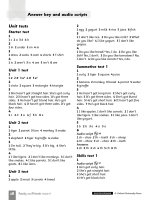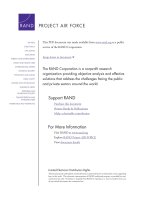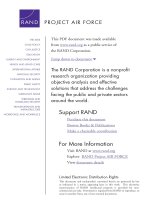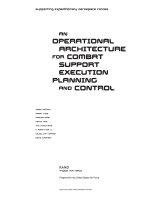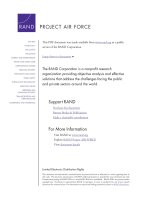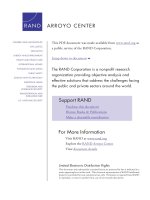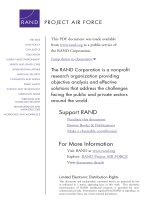Dessler HRM 12e ch 05 personnel planning and recruiting
Bạn đang xem bản rút gọn của tài liệu. Xem và tải ngay bản đầy đủ của tài liệu tại đây (1.12 MB, 52 trang )
Chapter 5
Personnel Planning
and Recruiting
Part Two | Recruitment and Placement
Copyright © 2011 Pearson Education, Inc.
publishing as Prentice Hall
PowerPoint Presentation by Charlie Cook
The University of West Alabama
WHERE WE ARE NOW…
Copyright © 2011 Pearson Education, Inc. publishing as Prentice Hall
5–2
LEARNING OUTCOMES
1. List the steps in the recruitment and selection process.
2. Explain the main techniques used in employment
planning and forecasting.
3. Explain and give examples for the need for effective
recruiting.
4. Name and describe the main internal sources of
candidates.
5. List and discuss the main outside sources of
candidates.
6. Develop a help wanted ad.
7. Explain how to recruit a more diverse workforce.
Copyright © 2011 Pearson Education, Inc. publishing as Prentice Hall
5–3
The Recruitment and Selection
Process
1. Decide what positions to fill through personnel
planning and forecasting.
2. Build a candidate pool by recruiting internal or external
candidates.
3. Have candidates complete application forms and
undergo initial screening interviews.
4. Use selection tools to identify viable candidates.
5. Decide who to make an offer to, by having the
supervisor and others interview the candidates.
Copyright © 2011 Pearson Education, Inc. publishing as Prentice Hall
5–4
FIGURE 5–1
Steps in Recruitment and Selection Process
The recruitment and selection process is a series of hurdles aimed at selecting the best candidate for the job.
Copyright © 2011 Pearson Education, Inc. publishing as Prentice Hall
5–5
FIGURE 5–2
Linking Employer’s Strategy to Plans
Copyright © 2011 Pearson Education, Inc. publishing as Prentice Hall
5–6
Planning and Forecasting
• Employment or Personnel Planning
The process of deciding what positions
the firm will have to fill, and how to fill them.
• Succession Planning
The process of deciding how to fill the
company’s most important executive jobs.
• What to Forecast?
Overall personnel needs
The supply of inside candidates
The supply of outside candidates
Copyright © 2011 Pearson Education, Inc. publishing as Prentice Hall
5–7
Forecasting Personnel Needs
Forecasting Tools
Trend analysis
Ratio analysis
Copyright © 2011 Pearson Education, Inc. publishing as Prentice Hall
Scatter plotting
5–8
FIGURE 5–3
Determining the Relationship Between
Hospital Size and Number of Nurses
Hospital Size
(Number
of Beds)
Number of
Registered
Nurses
200
240
300
260
400
470
500
500
600
620
700
660
800
820
900
860
Note: After fitting the line,
you can project how many
employees are needed,
given your projected
volume.
Copyright © 2011 Pearson Education, Inc. publishing as Prentice Hall
5–9
Drawbacks to Traditional
Forecasting Techniques
• They focus on projections and historical relationships.
• They do not consider the impact of strategic initiatives on
future staffing levels.
• They support compensation plans that reward managers
for managing ever-larger staffs.
• They “bake in” the idea that staff increases are
inevitable.
• They validate and institutionalize present planning
processes and the usual ways of doing things.
Copyright © 2011 Pearson Education, Inc. publishing as Prentice Hall
5–10
Using Computers to Forecast
Personnel Requirements
• Computerized Forecasts
Software that estimates future staffing needs by:
Projecting sales, volume of production, and personnel
required to maintain different volumes of output.
Forecasting staffing levels for direct labor, indirect staff, and
exempt staff.
Creating metrics for direct labor hours and three sales
projection scenarios—minimum, maximum, and probable.
Copyright © 2011 Pearson Education, Inc. publishing as Prentice Hall
5–11
Forecasting the Supply
of Inside Candidates
Qualification
Inventories
Manual systems and
replacement charts
Copyright © 2011 Pearson Education, Inc. publishing as Prentice Hall
Computerized skills
inventories
5–12
FIGURE 5–4
Management Replacement Chart Showing Development
Needs of Potential Future Divisional Vice Presidents
Copyright © 2011 Pearson Education, Inc. publishing as Prentice Hall
5–13
The Matter of Privacy
• Ensuring the Security of HR Information
Control of HR information through access matrices
Access to records and employee privacy
• Legal Considerations
The Federal Privacy Act of 1974
New York Personal Privacy Act of 1985
HIPAA
Americans with Disabilities Act
Copyright © 2011 Pearson Education, Inc. publishing as Prentice Hall
5–14
Forecasting Outside Candidate
Supply
• Factors In Supply of Outside Candidates
General economic conditions
Expected unemployment rate
• Sources of Information
Periodic forecasts in business publications
Online economic projections
U.S. Congressional Budget Office (CBO)
U.S. Department of Labor’s O*NET™
Bureau of Labor Statistics (BLS)
Other federal agencies and private sources
Copyright © 2011 Pearson Education, Inc. publishing as Prentice Hall
5–15
The Need for Effective Recruiting
Recruiting Challenges
Effectiveness of
chosen recruiting
methods
Effects of
nonrecruitment
issues and policies
Copyright © 2011 Pearson Education, Inc. publishing as Prentice Hall
Legal requirements
associated with
employment laws
5–16
Effective Recruiting
• External Factors Affecting Recruiting
Supply of workers
Outsourcing of white-collar jobs
Fewer “qualified” candidates
• Other Factors Affecting Recruiting Success
Consistency of recruitment with strategic goals
Types of jobs recruited and recruiting methods
Nonrecruitment HR issues and policies
Successful prescreening of applicants
Public image of the firm
Employment laws
Copyright © 2011 Pearson Education, Inc. publishing as Prentice Hall
5–17
Organizing How You Recruit
Advantages of Centralizing Recruiting Efforts
Facilitates
strategic
priorities
Reduces
duplication of
HR activities
Copyright © 2011 Pearson Education, Inc. publishing as Prentice Hall
Ensures
compliance with
EEO laws
Fosters effective
use of online
recruiting
5–18
Measuring Recruiting Effectiveness
Evaluating Recruiting
Effectiveness
What to
measure
Copyright © 2011 Pearson Education, Inc. publishing as Prentice Hall
How to
measure
5–19
FIGURE 5–6
Recruiting Yield Pyramid
●
50% ● ●
67% ● ● ●
75% ● ● ● ●
16% ● ● ● ● ● ●
Copyright © 2011 Pearson Education, Inc. publishing as Prentice Hall
5–20
Internal Sources of Candidates
Advantages
• Foreknowledge of
candidates’ strengths
and weaknesses
• More accurate view of
candidate’s skills
• Candidates have a stronger
commitment
to the company
• Increases employee
morale
• Less training and
orientation required
Copyright © 2011 Pearson Education, Inc. publishing as Prentice Hall
Disadvantages
• Failed applicants become
discontented
• Time wasted interviewing
inside candidates who will
not be considered
• Inbreeding strengthens
tendency to maintain the
status quo
5–21
Finding Internal Candidates
Hiring-from-Within Tasks
Posting open
job positions
Rehiring former
employees
Copyright © 2011 Pearson Education, Inc. publishing as Prentice Hall
Succession
planning (HRIS)
5–22
Outside Sources of Candidates
Locating Outside Candidates
1
Recruiting via the Internet
6
Executive Recruiters
2
Advertising
7
On Demand Recruiting
Services (ODRS)
3
Employment Agencies
8
College Recruiting
4
Temp Agencies and Alternative
Staffing
9
Referrals and Walk-ins
5
Offshoring/Outsourcing
Copyright © 2011 Pearson Education, Inc. publishing as Prentice Hall
5–23
FIGURE 5–7
Some Top Online Recruiting Job Boards
Copyright © 2011 Pearson Education, Inc. publishing as Prentice Hall
5–24
Recruiting via the Internet
• Advantages
Cost-effective way to publicize job openings
More applicants attracted over a longer period
Immediate applicant responses
Online prescreening of applicants
Links to other job search sites
Automation of applicant tracking and evaluation
• Disadvantages
Exclusion of older and minority workers
Unqualified applicants overload the system
Personal information privacy concerns of applicants
Copyright © 2011 Pearson Education, Inc. publishing as Prentice Hall
5–25

